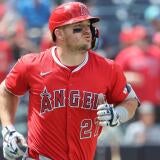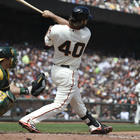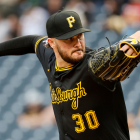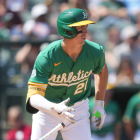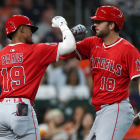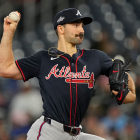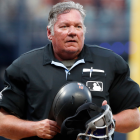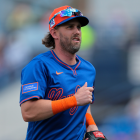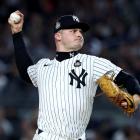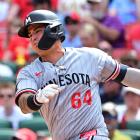You can, without much difficulty, portray the study of numbers as a heartless pursuit, one that seeks to take the magic out of baseball and turn it into something cold and unfeeling. But those of us who follow and crunch stats for a living see the exact opposite. To us, numbers can accentuate the action on the field. Sometimes, they can even tell a story better than straight observation with our eyes ever could.
On Thursday, Ryan Spaeder, an entertaining and informative follow on Twitter, tweeted one of the most jarring statistical nuggets I've ever seen. In fewer than 140 characters, he perfectly told the story of one pitcher's dominance ... at the plate.
#Nationals Bryce Harper
— Ace of MLB Stats (@theaceofspaeder) June 2, 2016
Last 190 PA: 11 HR#Angels Mike Trout
Last 190 PA: 11 HR#SFGiants Madison Bumgarner
Last 190 PA: 11 HR
Sure, you can argue that this example is a bit cherry-picked, that there are arbitrary end points in play which help make the point. Still, the upshot is pretty simple. Madison Bumgarner is a power-hitting machine, and the implications could be both historic and tons of fun.
Let's start with this: Even for a pitcher, Bumgarner isn't a historically great hitter overall. Like pretty much every other pitcher in today's game, he struggles to make contact, and has a weak batting eye. He has batted .180/.220/.306 for his career, and a modest .150/.200/.375 this season. In 459 career plate appearances, he has struck out 154 times, while walking just 20 times.
In his two best offensive seasons, 2014 and 2015, he hit .258 with a .286 on-base percentage and .247 with a .275 OBP. Those are outstanding numbers for a pitcher, but still not enough by themselves to, say, argue in favor of abolishing the DH. Really, Bumgarner is more like the guy in your softball beer league who swings for the fences every time, usually looks bad doing it ... but does incredible things when he actually connects.
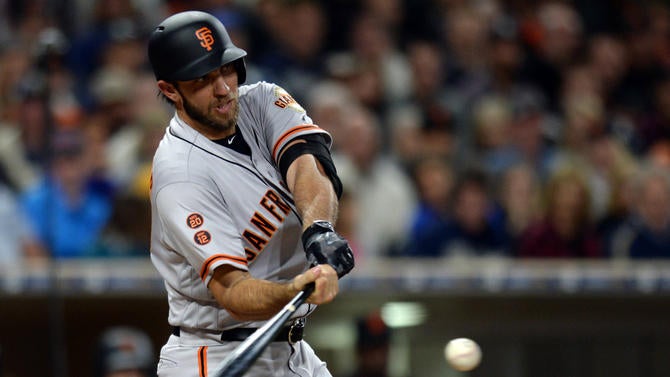
Those 11 homers that Bumgarner has hit since the start of the 2014 season project to 35 or more over a typical full season for a position player. Moreover, that total does in fact challenge the home-run pace set by some of the most powerful-hitting pitchers of all time. Thanks to the four-man rotations and sparse-to-nonexistent bullpens of the past, the best pitchers used to rack up something close to 190 plate appearances a season, which facilitates some apples-to-apples comparisons with Bumgarner's current power binge.
Wes Ferrell, the best-hitting pitcher baseball has seen since the start of the 20th century, batted an impressive .280/.351/.446 in his 15-year career playing for Cleveland, Washington, Brooklyn, the Yankees and Boston's Red Sox and Braves. He also holds the record for most home runs in a season since 1900, with nine (in just 129 plate appearances) in 1931. Ferrell batted .319/.373/.621(!!!) that year, one of three full seasons in which he fared at least 40 percent better than the average major-league hitter for any position. He clubbed 38 career homers, as well as 57 doubles and 12 triples -- 12 triples! -- in 1,345 plate appearances. Still, at no point in Ferrell's career did he ever hit 11 home runs in a season, or for that matter 11 in 190 or fewer trips to the plate.
We can slice and dice this another way too. Let's look at all pitchers with 60 or more plate appearances (roughly two per game for the typical 30-plus starts you'll get in the five-man era) and see how frequently each pitcher hit a home run, as measured by the years in which we have data for homers-per-fly-ball rate. The leaderboard:
| YEAR | PITCHER | HR/FB RATE |
| 2004 | Carlos Zambrano | 50% |
| 2004 | Kaz Ishii | 50% |
| 2006 | Carlos Zambrano | 46.2% |
| 2009 | Josh Johnson | 42.9% |
| 2003 | Carlos Zambrano | 40% |
| 2003 | Kerry Wood | 33.3% |
| 2003 | Brooks Kieschnick | 31.8% |
| 2008 | Carlos Zambrano | 30.8% |
| 2014 | Madison Bumgarner | 28.6% |
| 2015 | Madison Bumgarner | 26.3% |
Small sample sizes abound, led by Ishii hitting only two fly balls in that entire 2004 season, with one of them going over the fence. Still, once we get past those low-fly ball/low-homer seasons, as well as Kieschnick, a former two-way player who was barely good enough on the mound to keep as a mop-up reliever, we see that Bumgarner's modern-day equivalent might be Zambrano.
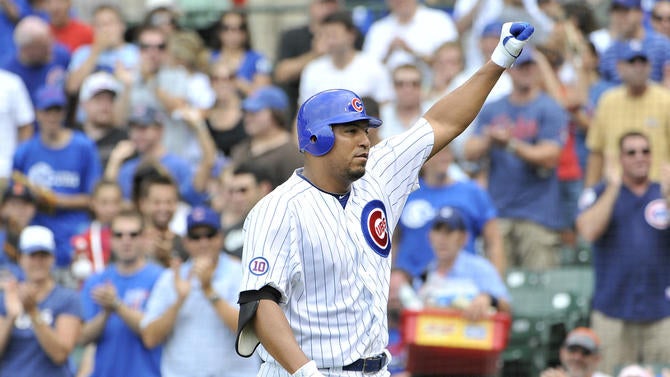
Like Bumgarner, Zambrano wasn't subtle: He struck out 240 times and walked just 10 times in 744 career trips to the plate. But he also posted some lofty power numbers, with a career-best six long balls in 2006, and a 2008 season in which he struck out 24 times without a walk ... but also hit .337 with four homers, four doubles and a triple in 85 PA. Zambrano held a significant edge over Bumgarner in one respect, though: With the wind blowing out, Wrigley Field has always been a place that could turn otherwise harmless fly balls into big flies.
So really, Bumgarner's best post-integration comp might be Don Drysdale. Sandy Koufax's wingman during the Dodgers' great run in the early-to-mid 1960s, Drysdale was a truly excellent pitcher, much like Bumgarner is today. His pitching numbers were helped a lot by his home park -- Dodger Stadium was the toughest place in the National League to hit in Drysdale's era, just as AT&T Park is one of the toughest hitters' parks in the NL over the past three years.
But we can flip that around too. It took a rocket launcher to hit a ball out of Dodger Stadium in the mid-'60s, thanks to both the park's dimensions and the sky-high mound that Drysdale pitched on. Yet Drysdale still posted a few very good offensive seasons, including a 1965 campaign in which he batted .300/.331/.508 with seven homers in 138 plate appearances -- 40 percent better than the league-average hitter after adjusting for both that era and the ballpark.
And while Bumgarner has never put up offensive numbers that good, we should still grade him on a curve, given how thoroughly AT&T typically suppresses hitting, especially home runs. (It does help that Bumgarner is a right-handed batter, as AT&T is tougher on lefty-swinging batters than righties when it comes to round-trippers.)
Aside from the important matter of Giants wins and losses, Bumgarner's power could barge into the spotlight another way. The best power-hitting pitcher in the league wants to compete in next month's Home Run Derby during All-Star festivities in San Diego. At first, this might sound crazy. Then again, the Derby is a meaningless but fun event within a meaningless (or almost meaningless, thanks to Bud Selig looking like a fool in 2002) but fun three days that otherwise merely mark a break in the schedule.
Watching a pitcher swing for the moon alongside the game's greatest sluggers would be a blast. Given Bumgarner's recent home-run pace and his ability to hit the ball a mile when he makes contact, who knows?
He might even surprise us.
![[object Object] Logo](https://sportshub.cbsistatic.com/i/2020/04/22/e9ceb731-8b3f-4c60-98fe-090ab66a2997/screen-shot-2020-04-22-at-11-04-56-am.png)





